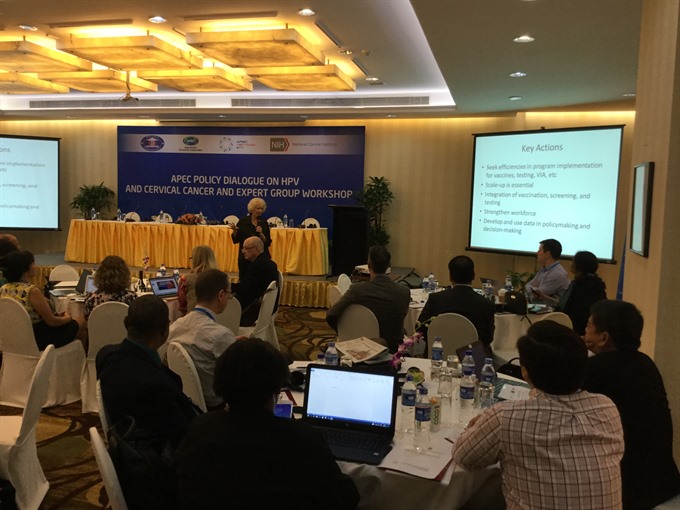 Society
Society

" />Vaccine coverage against the human papilloma virus (HPV) should be expanded to help reduce new incidences of cervical cancer, experts said at an APEC meeting.
 |
| The APEC Policy Dialogue on HPV and Cervical Cancer discusses HPV vaccination programmes and future plans as well as goals for reducing HPV infections and incidences of cervical cancer in the region. —VNS Photo Gia Lộc |
HCM CITY — Vaccine coverage against the human papilloma virus (HPV) should be expanded to help reduce new incidences of cervical cancer, experts said at an APEC meeting.
At the APEC Policy Dialogue on HPV and Cervical Cancer, which ended yesterday in HCM City, participants discussed the rolling out of HPV vaccination programmes and future plans and goals for reducing HPV and cervical cancer in APEC economies.
Global studies estimating the potential impact of HPV vaccinations and the cost of delays were also presented.
“Cervical cancer is highly preventable with an HPV vaccine and generally curable if diagnosed and treated early,” Việt Nam’s Deputy Minister of Health Nguyễn Viết Tiến said at the meeting.
Despite this, 528,000 new incidences of cervical cancer occurred in 2012 around the world and more than 266,000 people died needlessly from the disease, Tiến said.
Nearly 90 per cent of the fatalities were living in low- and middle- income countries and territories, he said, adding that only one in 10 girls in those countries have access to HPV vaccines, compared to nine in 10 girls in high-income countries.
For primary prevention, a pilot programme supported by the Global Alliance for Vaccines and Immunization (GAVI) provided HPV vaccines to 6,000 teenagers from 2008 to 2010 in Việt Nam.
However, “the current coverage of HPV vaccination in Việt Nam still is low because of the high costs of HPV vaccines,” Tiến told Việt Nam News on the sidelines of the APEC Policy Dialogue.
“More strategies are needed to raise vaccination coverage in Việt Nam,” he said, adding a specific agency in charge of buying vaccines would help reduce the cost.
Dr Trần Văn Thuấn, director of the National Institute for Cancer Control in Hà Nội, said that many countries in the world were using the HPV vaccines in their national programmes on immunisation, which has helped reduce the incidences of cervical cancer.
Each year, 5,600 women die from cervical cancer in Việt Nam, Thuấn said.
“In Việt Nam, cervical cancer ranks the fourth of the most common cancers and the sixth leading cause of cancer fatalities among women,” Tiến said.
Professor You-Lin Qiao of the Chinese Academy of Medical Sciences said that the price of the vaccines were very expensive. In China, vaccines can cost around $100 for one dose, he said.
Assoc Professor Marion Saville, executive director at Victorian Cytology Service Ltd, said that in Australia, the government has funded HPV vaccines for teenage girls since 2007 and for teenage boys since 2013.
“We’re very lucky that parents can send their kids for vaccinations at no costs through school-based delivery of vaccination,” she said.
School-based delivery is good for maximizing uptake but also maximizing equity so that children and teenagers who come from poorer parts of Australia are as likely to be vaccinated as children from the wealthier parts, Saville said.
The vaccination is convenient and affordable in Australia, she said, adding: “With that we have very high three-dose completion rate. It is highly cost-effective to prevent cancer through vaccinations.”
Vaccination coverage is a good investment. Combined with government efforts and GAVI, getting vaccines to girls between the age of 9 and 12 would help reduce the number of cervix cancer cases in the region, according to Saville.
Dr Lokky Wai, representative of the World Health Organisation Western Pacific Region, said: “To increase the rate of vaccine coverage, we need to overcome a number of challenges, besides the high cost of procuring the vaccines.”
Proper communication or education about cervical cancer and its causes, safety and effectiveness of HPV vaccines and dispelling rumors or myths about vaccines are challenges that need to be tackled, Wai said.
“We also need strong commitments from the highest level of governments to support, promote and mobilize communities to recognize the danger of HPV infections and accept and use the vaccines,” he said.
The two vaccines currently available protect against some of the most common types of HPV (16 and 18) which are known to cause at least 70 per cent of cervical cancers.
The vaccines may also offer cross-protection against other less common HPV types which cause cervical cancer. Both vaccines are safe and very effective in preventing infection with HPV16 and 18.
Comprehensive approach
Vaccinations against HPV, however, are not enough, Wai said, adding that to reduce cervical cancer a comprehensive approach is needed.
Provision of regular screening services, proper education about sexual practices, and reduction in smoking prevalence are all issues that need to be resolved to substantially reduce cervical cancer incidences, he said.
Health deputy minister Tiến said that Việt Nam had been applying strategies toward eradicating HPV infection and significantly reducing incidences of cervical cancer.
Media campaigns to improve awareness of the prevention and early diagnosis of cervical cancer has been carried out throughout the country, Tiến said.
Cervical cancer screening and treatment has been part of the National Strategy on Reproductive Health Care since 2001 and the National Cancer Control Programme since 2008.
“A population-based cervical cancer screening programme was implemented in specific regions of the country, using cytology or visual inspection with acetic acid (VIA) methods,” Tiến said.
Clinical guidelines for cervical cancer diagnosis and treatment were approved by Việt Nam’s Ministry of Health in 2011, and have been updated frequently.
“However, like many APEC developing economies, Việt Nam faces financing issues, including the high costs of HPV vaccination, limited access to health services in rural remote areas, lack of cytology laboratories and high quality cytologists, among others,” Tiến added.
Việt Nam will take advantage of new innovations to provide people primary levels of care and essential health services that are accessible, safe, effective and affordable, he said. —VNS




